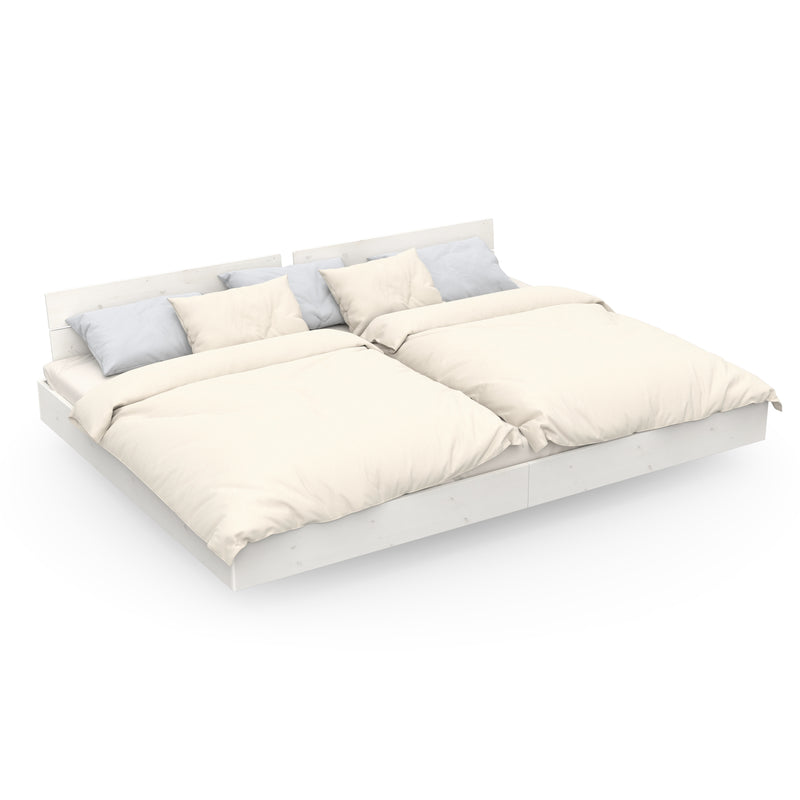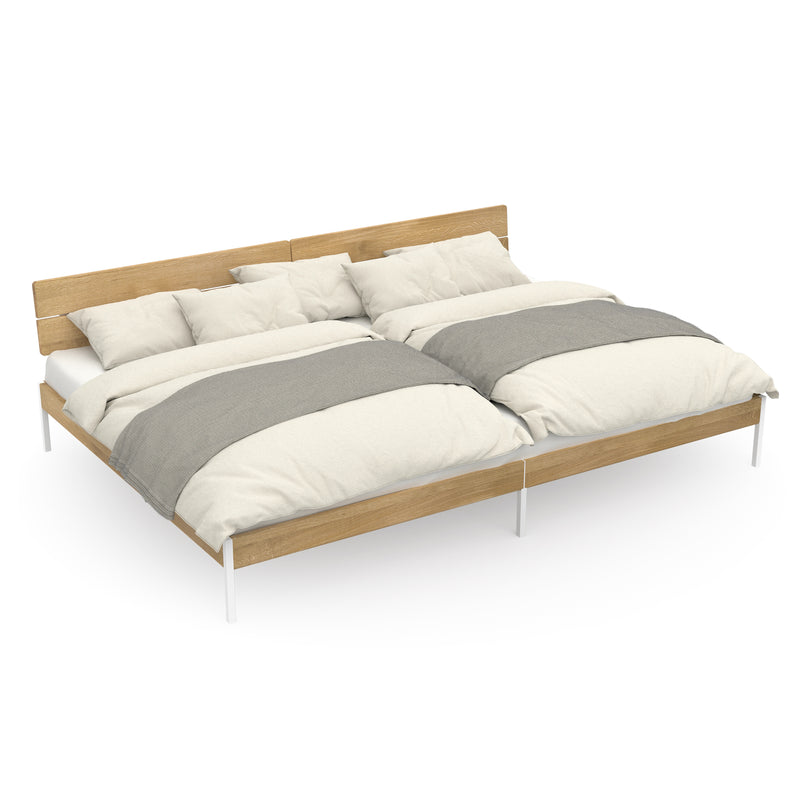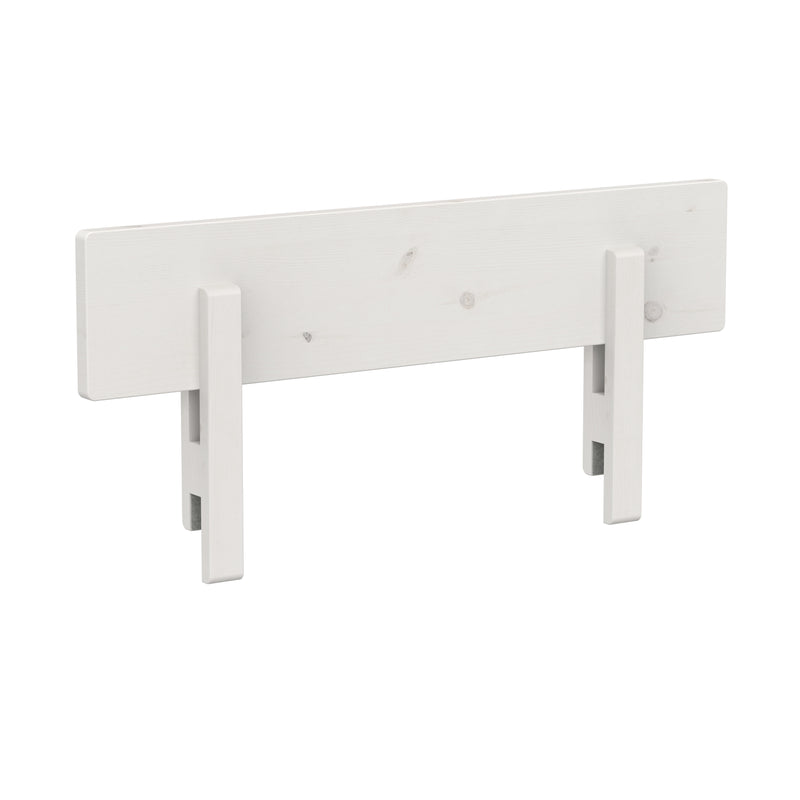
Family bed is trendy: parents and children sleep together. Find out more about sizes, types, pros & cons, as well as important tips for co-sleeping.
Sleeping together: tradition or trend?
In many cultures, it is taken for granted that the family sleeps together in one big bed. This creates closeness and security - and is often not possible any other way for reasons of space. In this country, too, the concept of sleeping together is becoming more and more popular - we have taken a liking to the subject and, with the "Swebe" model in various sizes, are making our own Family beds.
But which solution is the right one for you? Different formats, fold-out or pull-out models and family beds with storage space present you with a choice. In this article we explain what exactly a family bed is, what types there are and what advantages and disadvantages a "co-sleeping bed" has.
What is a family bed?
Basically, "family bed" is not a fixed term. It simply refers to the bed in which the family sleeps together. Often this is the parental bed - which is quickly converted into a family bed when the little ones join them at night. But by the second child at the latest, the double bed becomes cramped.
We therefore also use the term for sleeping solutions that have been designed to accommodate all family members comfortably. And without anyone falling out or getting stuck between two mattresses. Instead, there is ideally a large lying surface on which young and old can criss-cross.
The different types of family beds
The most important criterion for choosing the right family bed is the available space. Some bedrooms are so narrow that an XXL family bed simply won't fit. Therefore, especially in small flats, creative ideas are needed on how to enlarge the bed to make it a sleeping place for the whole family. Or how to gain space for clothes and bed linen.
For example, there are family beds with storage space in the form of bed drawers. You can also design the family bed as a bunk bed, where the parents sleep below and a (bigger) child in a superstructure above. If there are more children, a bed extension makes room for the smallest ones - with a pull-out family bed or in the form of an extra bed.
Tip: Normal children's or junior beds can also be used as an extension to the family bed. Simply leave out one side rail and place the cot very close to the parents' bed. The gap between the mattresses can be filled with a rolled towel or a side sleeper pillow. This way you can try out whether a real family bed would be a good solution for you. But be careful: you have to attach the extra bed to the parents' bed so that it doesn't slip and create a gap.
Family bed - which size?
The question of the type of family bed is accompanied by the question of the size. This can be determined by two factors: The available space and the size of the family. For sleeping, you should calculate about 70 to 90 cm width per person. You should also adhere to this for small children, as they move around more frequently during sleep and to avoid heat accumulation.

The common sizes for family beds range from 240x200 to 300x200 cm. There are several gradations in between - for example, there is comfortable room for three in the family bed with 240x200 cm. More freedom of movement is offered by a family bed in 270x200 cm size. From school age at the latest, most kids still want to sleep in their own bed, so that there is room for the smaller family offspring again. If there are no more children, you can convert the family bed Swebe back into a normal double bed with our extension set.
If, on the other hand, you want to keep the concept of co-sleeping with your older children or if you have several small children at the same time, then you should think about a really large lying surface. A family bed of 300x200 cm or larger is suitable for this need. A compromise that also offers bigger kids more privacy is a bunk bed as an extended XXL family bed.
Tip: Finding the right mattress is a bit of a challenge. Because to prevent babies and small children from hurting themselves, there should be no bed gaps. However, wide mattresses are difficult to transport. One solution, for example, is special slit fillers. This way you can connect a double mattress with a single mattress on a family bed 270x200 cm wide. The good thing about this is that the mattress firmness can be adjusted to suit different preferences.
Family bed: The advantages and disadvantages
A family bed has many advantages: Mum or Dad don't have to get up at night if the little ones cry. They, in turn, can snuggle up close to their parents if wild dreams or loud noises wake them up.
Breastfeeding at night in the family bed is also more pleasant with a breastfeeding baby: the mother can simply put on the breast and continue dozing. In addition, the closeness is good for all family members and strengthens the bond between them. According to studies, babies wake up less often and fall asleep faster when they sleep in bed with their parents.
Possible disadvantages
What keeps many young parents from choosing the family bed is the fear of sudden infant death syndrome (SIDS). However, so far no scientific studies have been able to prove a real connection between the type of sleep and the occurrence of SIDS.
Good to know: Some sources (e.g. here) even attribute sleeping in the family bed to counteract SIDS. One reason for this is the irregular breathing of babies in deep sleep. In the family bed, deep sleep phases are said to be shortened, which can promote a healthy sleep rhythm.
Apart from the fear of SIDS, there are other arguments against the co-sleeping bed. For example, one parent may find his or her night's rest disturbed. This is because children between the ages of two and three in particular often move around during sleep. This can lead to insomnia and discord. It can also be difficult to find the right mattress: Often enough, one partner likes to sleep softer than the other. For the smallest ones, on the other hand, a hard base is safest. The "accessories" go hand in hand with this: the sheet for the family bed always has to be oversized.
Last but not least, the purchase of a family bed is also a question of space and price. As far as space is concerned, there are various options: From family beds with a fixed lying surface to extendable models or bunk beds with and without storage space. Particularly affordable are family beds where the bed frame consists only of a slatted frame with legs. A stylish and simple solution for a restful, natural sleep is our "Swebe" family bed made of durable solid wood.
Co-sleeping is a matter of consideration
|
Pro family bed |
Contra family bed |
|
You only need one bedroom for the whole family |
Some bedrooms are too narrow for a large family bed |
|
Besides, only one bed needs to be bought |
Extensions may still be expensive; in addition, oversized sheets must be provided |
|
Co-sleeping strengthens the bond within the family |
Sleep quality may suffer |
|
Sleeping in the family bed ensures quieter nights, especially for babies and breastfeeding mothers, as there is no need to get up at night. |
|
In addition to these pros and cons, there may be individual reasons for or against sleeping together. It's best to make your own list and discuss with your children and partner whether a family bed is the right choice for you.
Family bed? But safe: What should be considered when co-sleeping?
As enthusiastic as we are about co-sleeping for families, we are of course aware that some precautions need to be taken for safety reasons. For example, a fall-out-protection is needed for the lounging area if one or both sides of the family bed are not directly against the wall.

This way you can leave the room in the evening when the little ones are asleep and you still have things to do. And you sleep more peacefully when you know that my child can't fall out of bed even though he or she is sleeping. Especially with two small children, a fall-out protection is indispensable. Because in order to make the co-sleeping bed safe for everyone, an adult should always lie between two children - and one child necessarily lies on the outside.
Safety of babies in the family bed
To keep babies safe in the family bed, it is important to avoid blankets and pillows as much as possible. The baby itself sleeps best in a sleeping bag, without an additional blanket etc. It is also important that the child cannot slip into a bed slit and that the base is as hard and breathable as possible - a waterbed is not suitable as a family bed! A simple wooden frame or a plain family bed made of solid wood is better and also ensures a good room climate.
Also important in terms of safety:
- If a parent has consumed excessive alcohol or medication, parents and children must not share the family bed (read more here)
- Smokers should not sleep in a co-sleeping bed with their children, as children can absorb pollutants through their breath.
- Babies should sleep in the supine position and not be wrapped up too warmly.
- The ideal sleeping temperature for babies is 16 to 18 °C.
Especially for the last reason: the more space the family bed offers, the better.
Conclusion: We like
We at ekomia are big fans of family beds. With our "Swebe" model, we have designed a bed whose minimalist style fits into any bedroom. The sturdy frame made of solid wood provides a safe, natural night's sleep for young and old alike.
However, one thing is clear: the decision for or against a family bed should be carefully discussed together. After all, the needs of all family members must be respected. If the decision is made in favour of the co-sleeping bed, then it's time to choose the right model.
Small rooms may need more flexible design options - such as bed drawers, extensions or even a bunk bed solution. Last but not least, you should take our safety tips to heart so that even the smallest ones can sleep safely and peacefully through the night.
Frequently asked questions about the family bed
Is a family bed safe for babies?
If you follow a few rules, babies will sleep safely in the family bed. For example, the child should have enough space to sleep. Use as few blankets and pillows as possible - a sleeping bag is enough. Taboo: After excessive alcohol or medication consumption, baby and parents must not sleep in the same bed.
What are the advantages of a family bed?
Especially for breastfeeding mothers, a family bed is comfortable because you can put your baby to sleep and continue dozing. In addition, sleeping together strengthens the bond between parents and children. Another pro: You only need one bedroom and one large bed.
Frequently asked questions
Here we have answered frequently asked questions from other users on the topic Is a family bed right for us?
Comments
Do you have any questions or comments on this topic? Write a comment, we will be happy to answer.





